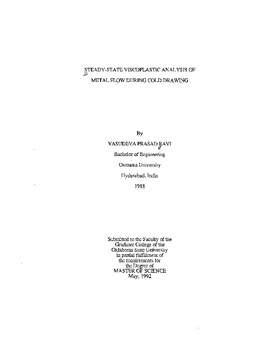| dc.contributor.author | Ravi, Vasudeva Prasad | |
| dc.date.accessioned | 2014-11-03T16:09:13Z | |
| dc.date.available | 2014-11-03T16:09:13Z | |
| dc.date.issued | 1992-05-01 | |
| dc.identifier.uri | https://hdl.handle.net/11244/13542 | |
| dc.description.abstract | The three-dimensional finite-element method is applied to the metal forming process of drawing rectangular bars from rectangular billets. The rigid-viscoplastic formulation is modified to incorporate the steady-state nature of the drawing process. Various methods of analysis of the drawing process are summarized. Application of the three-dimensional finite element method to other forming process like forging, rolling and extrusion are reviewed. Also presented is the finite element method applied to the analysis of steady-state processes. Simulations were performed under various conditions of the process parameters such as drawing velocity, die-workpiece interface friction, die angle, and area reduction. Velocity distributions, steady-state drawing loads, die-pressure distribution, flow stress, average stresses, effective strain-rates and principle stresses predicted for different simulation conditions are compared. The results are then discussed to gain insight into the mechanics of metal deformation during drawing. | |
| dc.format | application/pdf | |
| dc.language | en_US | |
| dc.publisher | Oklahoma State University | |
| dc.rights | Copyright is held by the author who has granted the Oklahoma State University Library the non-exclusive right to share this material in its institutional repository. Contact Digital Library Services at lib-dls@okstate.edu or 405-744-9161 for the permission policy on the use, reproduction or distribution of this material. | |
| dc.title | Steady-state viscoplastic analysis of metal flow during cold drawing | |
| dc.type | text | |
| osu.filename | Thesis-1992-R2565s.pdf | |
| osu.accesstype | Open Access | |
| dc.description.department | Mechanical Engineering | |
| dc.type.genre | Thesis | |
